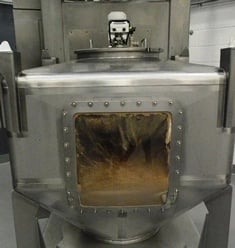Having selected to use tumble blending for your powders, how do you know what settings are the best to use?
It's important to identify which blender rotation speed will mix your recipe effectively. The blender can be set to rotate at different speeds from 4 to 18 rpm to match the characteristics of your powder mix whether that is a friable or a cohesive material.
In this blog we help you find the right rotation speed for your ingredients.
Match the spin to the material
By adjusting the rotation speed of the blender the level of energy applied to the contents of the IBC can be increased or reduced to suit the material within the container.
Mixtures with free-flowing, friable ingredients or large particle size differentials will benefit from a lower rotation speed, keeping the shear and centrifugal forces to a minimum. The objective is to match the centrifugal to gravitational force preventing large particles from being segregated or damaging friable ingredients. Free-flowing products by their very nature will go from being homogenous to becoming de-mixed if you over-process them when blending.
More cohesive powders, on the other hand, will be commonly blended in the mid to upper rotation speed ranges as they require more energy to disrupt the inter-particle forces that make them cohesive. Once mixed however, the same forces reduce the potential for de-mixing.
Knowing the potential effects associated with rotation speed can help choose the right parameter for your application. It is important to understand the optimum blend time of your individual recipes as over or under mixing will result in poor product quality.
Scaling it up
When scaling from one IBC to another there are some basic guidelines to consider. 'Tip speed' is the speed at which the outer edges of the IBC travel along the blender rotation path. The diameter of this path varies with the IBC size, which means that the tip speed changes with path size variance while maintaining rotation speed. Changing the rotation speed allows the tip speed to be maintained between IBC sizes and helps to keep the mixing forces relative on the powder mass across a scaled batch.

The rotation number is the number of complete rotations the blender performs during a blend cycle. As a starting point the objective should be to keep this the same for both the original batch and the scaled-up batch.
Changing these parameters allows users of the Matcon IBC blender to scale up or down using known parameters to control variables and maintain mix quality.
Learn more about Intermediate Bulk Containers (IBCs)
Saving time is important
Another benefit of understanding your recipe blend times is that you may be able to reduce the amount of time spent on each blend. A saving of a couple of minutes might not sound much, but if that is for each batch many times per day it will soon add up and maybe additional batches can be mixed in a single shift, creating extra capacity or enabling shifts to be reduced.
All the proof you need
Before deciding on your tumble blender it is possible to conduct testing at one of the Matcon test plants around the world. We offer full-scale testing using your own powders, which our customers have found invaluable throughout the decades to reassure them in their decision making.
 Along with the full-scale testing we also offer the use of NIR (near infra-red spectroscopy) which enhances our understanding of the blending process. Not only will it demonstrate that tumble blending works with your materials it will also be able to give real-time results as the blender is in motion, which will identify the point at which the material becomes blended. The benefit of NIR is that it removes the need to use invasive sampling techniques, which can be time consuming and subject to inaccuracies by virtue of their methodology.
Along with the full-scale testing we also offer the use of NIR (near infra-red spectroscopy) which enhances our understanding of the blending process. Not only will it demonstrate that tumble blending works with your materials it will also be able to give real-time results as the blender is in motion, which will identify the point at which the material becomes blended. The benefit of NIR is that it removes the need to use invasive sampling techniques, which can be time consuming and subject to inaccuracies by virtue of their methodology.
By understanding the stable state of a mixture this narrows down any further work needing to be done back at the factory to set up a new production system using traditional analytical methods, thereby saving material costs, sampling costs and time. Once the blending time is established, this can be fed into the blender settings and used to optimise the blending cycle with the opportunity to save minutes in this process, which could lead to the ability to process additional batches within a shift.
To help guide you towards making an informed decision on which industrial mixer is right for you, we have created a useful tick list.
Topics:
Blending
